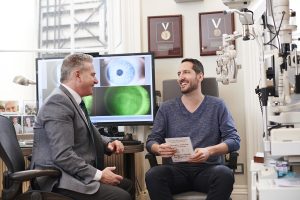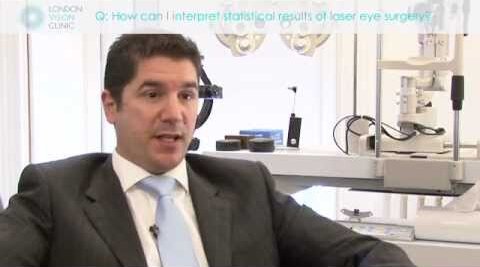How Do I Interpret Laser Eye Surgery Results?

When choosing a Laser Eye Surgery provider – or even when deciding whether to go ahead with treatment – it is important to be aware of the results of each clinic. This should help you to understand their results with prescriptions similar to yours and the likelihood of being able to achieve your desired results.
However, interpreting these results can often be difficult and outright confusing – after all, not everyone is a keen statistician! So, how do you interpret Laser Eye Surgery results?
The importance of publishing Laser Eye Surgery results
Making results easily accessible can be a sign of a good Laser Eye Surgery clinic, but that doesn’t mean they are always easy to understand. In some cases, advertised results can even be misleading, so it’s important to know what you should be looking for.
Most studies of Laser Eye Surgery Results will include the following three measures:
- The percentage of patients that achieved 20/20 (6/6) vision or better;
- The percentage of patients who achieved 20/40 (6/12) vision or better;
- The percentage of patients that achieve within one dioptre of zero prescription (emmetropia), meaning a final prescription of +1.00 or -1.00.
These groups will further be separated into prescription ranges (e.g., “the percentage of patients with a prescription of -3.00D who achieved 20/20 or better”).
This is important as it helps prospective patients to compare their likelihood of success with outcomes in prescriptions similar to their own. For example, if you have a high prescription of, say, -8.00D, focusing on data for patients with -3.00D would be misleading.
At London Vision Clinic, we regularly publish results in graphs that are designed to illustrate what is likely to be achieved through Laser Eye Surgery at our clinic. The way we publish our outcomes aims to make interpreting Laser Eye Surgery results as straightforward as possible.

Furthermore, as our expert surgeon, Mr Glenn Carp, explains in the video below, if you are still unsure, our patient care coordinators are always on hand to answer any queries you may have.
Unfortunately, not all clinics are as scrupulous when presenting their results (some may even manipulate their results!).
How standardised reporting could help
When it comes to specialised treatments such as refractive surgery, the value of publishing the outcomes for specific techniques and prescriptions cannot be overstated. However, things can get confusing when comparing results between several factors, such as different:
- Techniques
- Procedures
- Technology
- Surgeons
- Clinics
The value of publishing Laser Eye Surgery results can be maximised when outcomes are comparable to other published results – such as those from other clinics. This can best be achieved by peer-reviewed journals strictly adhering to a universal standard or format for reporting outcomes.
A Standardised Approach to Reporting
In 2000, world-renowned cornea and refractive specialist George O. Waring III, in association with the editorial staffs of the Journal of Refractive Surgery and the Journal of Cataract and Refractive Surgery, published an article titled “Standard Graphs for Reporting Refractive Surgery“.
This article set out a concise six-graph format for reporting clinical outcomes, covering four main areas: accuracy, efficacy, safety and stability. Despite this, many authors continued to publish refractive surgery outcomes based on different analysis and formatting methods. This has helped contribute to ongoing difficulties when comparing studies.
That’s why, over the years, our founder and lead surgeon, as well as a section editor and member of the board for the Journal of Refractive Surgery, Professor Dan Reinstein, has made it his mission to optimise the reporting of refractive surgery results.
Some of Professor Dan’s contributions
By improving the set of Standard Graphs (as published in an editorial in 2009), and lobbying the most prominent refractive journals to enforce this standard, Professor Dan has largely helped to achieve this aim. In January 2011, three of the top journals (Journal of Refractive Surgery, Journal of Cataract and Refractive Surgery, and Cornea) published a joint editorial stating their commitment to requiring these graphs to be included in any future refractive surgery outcomes paper.
Since then, improvements in reporting have continued to be made. These improvements should make it easier than ever before to compare clinics, and even surgeons, to ensure you have the very best opportunity to achieve the best possible results.
If you’d like to learn more about Laser Eye Surgery results at London Vision Clinic, get in touch with one of our friendly clinic coordinators or Book a Consultation today.


